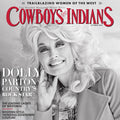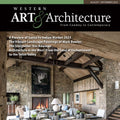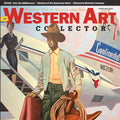Western Rivers, Western Art Collector, September 2010
By Medicine Man Gallery on
The River Wild
Artists capture the flow and rhythm of Western rivers on canvas
In 1857 Lt. Joseph C. Ives led a U.S. War Department expedition to the Grand Canyon area and reported back to Congress, “(The Grand Canyon) is, of course, altogether valueless. It can be approached only from the south, and after entering it there is nothing to do but leave. Ours has been the first, and will doubtless be the last, to visit this profitless locality. It seems intended by nature that the Colorado River, along the greater portion of its lonely and majestic way, shall be forever unvisited and undisturbed.”
Today, the Colorado is one of the most controlled rivers in the world providing recreation and irrigation for a wide area along its 1,450-mile length.
P.A. Nisbet spends long hours in the Grand Canyon and remote regions of the West, hiking, camping, and painting. His painting, Morning on the Colorado, captures a quiet stretch of the river as it continues to grind down the Grand Canyon. The painting epitomizes his passion for the landscape, which he describes poetically: “When I imagine the story of my own life, I see only this: A vast chromatic distance, a layered, transparent landscape, and a journey without a destination through great vaults of stone, light and space.” Morning on the Colorado won the Henry Farny Aard for Best Painting at the 2009 Quest for the West exhibition at the Eiteljorg Museum in Indianapolis, Indiana.

Merrill Mahaffey shows the results of river erosion in his painting Unstable Rocks calmly reflecting on the river’s flowing surface but ready to wreck havoc. He describes himself as a “spiritual naturalist.” Fascinated by the tumbled rocks of the Southwest, he describes his work as “a link between aesthetic and environmental concerns (bridging) realism with fractal modernism in an ever-evolving style…” In Unstable Rocks, he isolates the scene from its greater context and concentrates on geometry and subtle contrasts.
Unlike Lt. Ives, who was singularly unmoved by the majesty of the Colorado, Louisa McElwain identifies with the landscape of the West. She responds to the sensuality of the landscape as well as to the sensuality of paint itself. She has a feeling of oneness with her materials and her subjects.

“Sometimes I put little stones, bones or pieces of glass and plants into the paint, in the same spirit as the Navajo weaver who incorporates things into her blanket to bless those who will receive it, and as a way of acknowledging the temporality of things,” says McElwain. Her painting Cañon captures the energy of the flowing river and its effect on the rock walls with her characteristic thickly applied paint and strong color.
Diné artist Shonto Begay was born on a Navajo Reservation sheep camp in Arizona. His name, in Navajo, refers to “light reflecting off water.” Light plays a big role in Begay’s paintings and is represented by his characteristic swirling application of paint. In Night Wash, Indian women, water, stone, and sky appear to be made of the same substance. Solid elements seem to dissolve into the mist and clouds in one spiritual creation.
Begay is an advocate for the environment and often works with children to acquaint them with its riches. A stanza from his poem Early Spring is a gentle reminder for all of us:

For this generation, and many more to
Come, this land is beautiful and filled
With mysteries.
They reveal themselves and their
Stories – if you look very carefully,
And listen…



